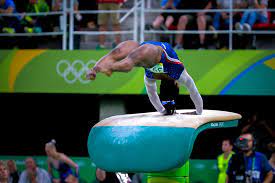
Gymnastics vault is considered by many to be the most exciting and dangerous event in artistic gymnastics. Female gymnasts perform gravity-defying feats as they sprint down the runway before launching themselves upside down off the vaulting table.
While vault difficulty has increased dramatically over the past few decades, some vaults stand out for their extreme technical difficulty and the sheer guts required to compete them.
Here are 6 of the hardest vaults in women’s gymnastics being performed today:
1. Produnova
The Produnova is undoubtedly the most notorious vault in women’s gymnastics. Dubbed the “vault of death,” it is named after Russian gymnast Yelena Produnova, who pioneered the skill in 1999. Only a handful of gymnasts have managed to compete this vault including Oksana Chusovitina and Yamilet Pena.
To perform the Produnova, the gymnast does a front handspring onto the vaulting table and pushes off into a double somersault before landing. Any slight error in timing or rotation can lead to catastrophic injury.
In men’s gymnastics the same vault is called The Roche named after Jorge Roche who successfully competed the vault in 1980. Twenty years later the same vault was being competed by women which demonstrates both the gap and progression of the two events.
Despite the risks, the Produnova remains popular because it starts from a high difficulty value from the code of points. It has though been overtaken by other harder vaults in the code.
2. Cheng
The Cheng vault was originally performed by Chinese gymnast Cheng Fei in 2005. It quickly gained popularity for its difficulty and was regarded as one of the hardest vaults in the sport.
To perform the Cheng, the gymnast does a round-off onto the vaulting table and pushes off into a laid-out salto with one and a half twists. The one and a half twisting laid-out flip requires tremendous height and delay in rotation. Gymnasts have to remain tight while twisting to avoid getting lost in the air.
While not as dangerous as the Produnova, the Cheng vault has carried an increased difficulty score in recent code changes and poses considerable risk to gymnasts’ knees and ankles on the landing.

3. The Biles
Simone Biles upgraded the Cheng vault by adding an additional half twist at the end of the vault. To date, she is the only female gymnast to have competed the vault with a full double twist in the layout position.
She first debuted the vault at the 2018 world championships and it was assigned a difficulty value equal to the Produnova.
3. Amanar
The Amanar vault, named after 1996 Olympic champion Simona Amanar of Romania, is a round-off entry onto the vaulting table followed by two and a half twists in a back salto.
With one of the highest difficulty scores, the Amanar vault separates elite vaulters from the rest of the pack. The extra half twist compared to the easier Yurchenko double full requires precision technique and timing to pull off successfully.
In recent years, Simone Biles has made this vault her signature. Her unmatched height and hang time in the air allow her to complete the two and a half twists with room to spare. Hitting an Amanar even gives Biles a sense of relaxation before she lands and readies herself for her next event.
4. Biles II
As the most decorated gymnast of all time, Simone Biles continues to push the boundaries of her sport. In 2019, she became the first woman to complete a triple twisting double back tuck on floor exercise and vault.
In 2021 Biles debuted a Yurchenko Double Pike which had never before been performed in competition by a female gymnast. As with every new gymnastics skill, it was submitted to the Federation of International Gymnastics (FIG) in time for the Tokyo Olympics however it was not performed due to Biles’s withdrawal from the finals.
As a result the Biles II didn’t get added to the Code of Points until the 2023 World Championships in Antwerp (see below).
No other female gymnasts have attempted this vault in competition. The Biles II exemplifies Simone’s unprecedented ability to create speeds rotations while maintaining complete awareness of her body’s position.
5. Full Twisting Yurchenko
Before the open-ended scoring system was adopted in 2006, the Yurchenko full twist was long considered the gold standard vault in women’s gymnastics. While less difficult by today’s standards, it remains an impressive vault requiring power, technique, and courage.
To perform the full twisting Yurchenko, gymnasts do a round-off onto the springboard and back handspring onto the vaulting table. They push off into a layout position and complete a full twist before landing.
Maintaining tight form throughout the flip and twist is crucial for control and to avoid injury. While gymnasts no longer rely on this vault to win medals, it is still used by many at the NCAA and club levels to develop more advanced skills.

6. Handspring Double Front
The handspring double front is an unusual vault that starts with a front handspring entry rather than the more traditional Yurchenko entry. The gymnast launches off the table into a piked double front flip without any twists.
Despite the lack of twists, this vault still carries a 6.4 difficulty score. The challenge lies in generating enough height and rotation to complete two front flips in a piked position. Gymnasts must aggressively drive off the table and maintain rigid form throughout to avoid landing short.
The handspring double front remains a fairly rare vault. It has been competed successfully by elites like Mykayla Skinner and Jade Carey who possess the power and technique to execute the precise, unconventional entry needed.
The Keys to Vault Success
Performing these ultra-difficult vaults requires immense courage, kinesthetic awareness, and technical mastery. Here are some of the key elements needed to succeed as an elite vaulter:
- Speed – Vaulters must aggressively sprint down the runway at maximum controllable speed to generate power off the table.
- Penetration – Shallow penetration off the table leads to insufficient height and rotation. Gymnasts must stay tight and drive shoulders forward.
- Block – An explosive block off hands and feet is needed for optimal lift off the table. Arms must be ramrod straight and fully extended.
- Height – Maximum height is needed to complete difficult twists and flips. Generating lift is about vertical – not horizontal – momentum.
- Delay – Vaulters at the elite level have learned to delay the initiation of flips and twists to make rotations easier.
- Spotting – Spotting the landing area early is critical for safety on blind landings. Vaulters use peripheral vision and keep their heads up.
- Sticking – Stuck landings require total control. Gymnasts must find the ground gently and absorb force through the balls of their feet.
The gymnasts who have mastered these hardest vaults combine tremendous athletic gifts with nerves of steel. Their ability to convert horizontal speed into vertical rise allows them to complete feats never before thought possible. Many male gymnasts have performed harder vaults than women but with the sport continuing to progress at a rapid pace, it’s exciting to imagine what new vault boundaries may be pushed in the future.
Sources
WAG Code of Points – Federation of International Gymnastics
FAQs
What is a Tsukahara in gymnastics?
A Tsukahara (soo-ka-hara or often pronounced sook for short) is a round-off on the vault followed by a backward somersault. This family of vaults has developed into multiple somersaults and twists being performed but all from the same entry of a round-off with the hands placed on the vault table. This type of vault was named after Japanese gymnast Mitsuo Tsukahara who first performed it in 1972.
Why did women’s gymnastics change the vault?
The modern gymnastics table was introduced at the 2000 Sydney Olympics and replaced the thinner, wider gymnastics vault due to many injuries occurring over the years. The modern vault table has a bigger surface area and allows gymnasts to perform more difficult vaults with less fear of the hands missing or sliding off of the vault.
Is women’s gymnastics harder than men’s?
Women’s gymnastics has some different attributes and qualities that are required compared to men’s gymnastics. For instance, the need to dance, leap and be elegant on the floor and the balance beam is an essential part of women’s gymnastics but not men’s. The emphasis on flexibility is greater as well.
Both women and men are expected to tumble, vault and swing powerfully around the bars however, men are generally able to perform more difficult skills than women.
What age do female gymnasts peak?
Female Olympic all-around champions in the last fifty years have all been teenagers and generally retire by the time they are in their early twenties. Some do go on for longer but this is unusual and leads most experts to agree that female gymnasts peak between the age of 16 and 20.
- How to Do a Back Handspring: Complete Step-by-Step GuideLearning how to do a back handspring is an exciting milestone for any gymnast. It builds confidence, agility, and forms the foundation for advanced tumbling… Read more: How to Do a Back Handspring: Complete Step-by-Step Guide
- How To Get Over a Mental Block In Gymnastics: A Complete GuideGymnastics is a sport that requires not only physical strength and skill but also mental strength. When a gymnast feels like they cannot attempt a… Read more: How To Get Over a Mental Block In Gymnastics: A Complete Guide
- The Best Leotard for Girls in 2025: What to Look ForFinding an ideal leotard for girls isn’t just about picking a dazzling design that sparkles (although it does help!). The leotard has to fit perfectly,… Read more: The Best Leotard for Girls in 2025: What to Look For
- The Best Gymnastics Shorts (Our Top Picks)The best gymnastics shorts are designed to be worn over the top of a leotard providing additional coverage around the upper legs, whilst allowing gymnasts… Read more: The Best Gymnastics Shorts (Our Top Picks)
- Decathlon Leotards – Are They Any Good?If you’re in the market for a new leotard, you may be wondering if Decathlon leotards are any good considering the low cost of their… Read more: Decathlon Leotards – Are They Any Good?
- A Complete Guide to Gymnastics Hand RipsAre you tired of dealing with painful gymnastics rips on your hands from training? Look no further – this article offers a comprehensive approach to… Read more: A Complete Guide to Gymnastics Hand Rips






